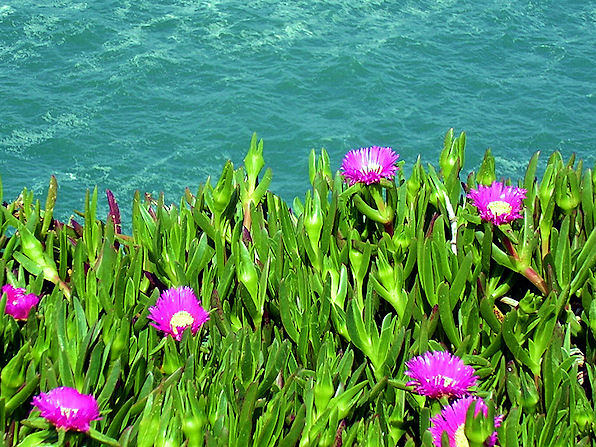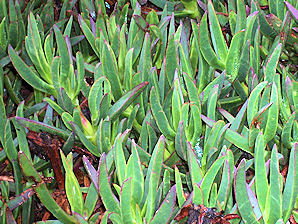Xeriscape Landscaping Plants For The Arizona Desert Environment.
Pictures, Photos, Information, Descriptions,
Images, & Reviews.
Groundcovers.
Hottentot Fig, Carpobrotus edulis.
We Are Proud Of Our SafeSurf Rating!
Click On Any Of The Following Links By Amazon.Com
For Books, & Videos About Wildflowers Of Arizona & The Southwest USA. No Obligation!
 |
| Plants. Hottentot Fig, Carpobrotus edulis. All Photos Courtesy: Wikipedia, the free encyclopedia. |
|---|
 | |
| Leaves, Hottentot Fig, Carpobrotus edulis. | Flowers. Hottentot Fig, Carpobrotus edulis. |
|---|
Hottentot Fig.
We wish to thank Wikipedia, the free encyclopedia for some of the information on this page. We share images and information with Wikipedia. Hottentot Fig is a perennial succulent from South Africa which has naturalised on the coasts of Southern and Western Europe including the UK. It has been used for years in California and Florida for erosion control. It now is considered invasive. It has triangular, fleshy, grey-green leaves borne on woody prostrate stems, and they taper at the end and and have a slight curve. Its has flowers from June to August, that are daisy-like, up to 5 inches across, they open up after noon time and turn pinkish later on in the day. The fruits are green, maturing to yellow , plump, flat at the top with several chambers. They are edible and can be used for a preserve.
Quick Notes:
Height: Height about 1 - 2 feet. Spreading about 2 - 4 feet.
Flowers: An array of colors including yellow, scarlet, magenta, red, and orange.
Flowering Time: Mid March - April.
Leaves: Evergreen, usually green, blue-green and fleshy.
Found: Native to coastal areas of South Africa, a region with a Mediterranean climate similar to that of coastal California. We see it throughout lower to higher elevations in Arizona as a landscape plant. The USDA claims it is native of the USA (CA).
Hardiness:
Soil pH requirements:
Sun Exposure:
Elevation: 0 to 2,900 feet In Arizona. In its native habitats, it is usually between 1,800 to 2,300 feet.
Habitat: Well-drained, sandy, poor to moderately fertile soils. A Xeriscape Landscape plant.
Miscellaneous: An ideal xeriscape landscape plant at low elevations in Arizona.
|
We Are Proud Of Our SafeSurf Rating!
Click On Any Of The Following Links By Amazon.Com
For Books, & Videos About Wildflowers Of Arizona & The Southwest USA. No Obligation!
| © 1966 - Present, Audrey, Eve, & George DeLange |
